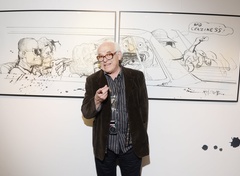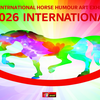You see them when you go to the beach, there's people drawing caricatures on the boardwalk. When you go to Six Flags you see the guy drawing people and they're all caricatures. When you look at a newspaper, you see caricatures of famous people (especially politicians). Yes, caricatures are indeed everywhere - but what does that mean? We called Justin BUA so we could hear from an expert about how to caricatures.

AW: So what defines caricatures? What makes something a caricature?
BUA: Well, caricatures are actually the spirt or the essence of somebody. Whereas a portrait is really trying to capture, in a naturalistic way, the likeness of the sitter. A caricature, in my opinion, goes one step beyond because it actually captures the spirit of somebody. So it doesn't even matter how distorted it is, it can be really out there and really capture the spirit of somebody. So that's what I feel a good caricature is all about.
AW: Which artists popularized the style? What's the history on caricatures?
BUA: Well, the history is obviously incredibly long but there's an artist by the name of Gustave Doré who was in my opinion did some of the greatest caricatures of all time. He was a political satirist - he did a lot of illustration stuff, a lot of book work, engravings of old fables and stories, stuff like Dante's Inferno.
There was another artist named Honoré Daumier. Daumier was a very great French painter. He did a lot of political paintings, and he did a lot of caricatures. He was really making fun of the aristocracy. He was making fun of the affluent, the wealthy, the popes and the kings, and the people who were monarchs, the people who had power.
Caricatures go back to the saying of "the pen is mightier than the sword". So if you can't really take arms against somebody, you can certainly do a caricature of them. You can defame them, you can ruin them, you can insult them, you can joke, you can mock them. What's worse - getting punched in the face, getting your riches taken away, or having someone be mocked by a caricature? Sometimes a caricature can go way deeper and penetrate someone's ego, and that's where the saying "The Pen Is Mightier Than The Sword" expression comes from.

AW: That reminds me of a political cartoon in a newspaper. Would that be an example of caricatures?
BUA: Absolutely, there's a lot of guys who are doing political satire caricature stuff all the time. Mad Magazine guys are political caricature artists. There's a lot of different types and clearly just like anything else, there's people who are not very good and there's people who are extraordinary.

AW: So let's talk about that. What's the mark of a good caricature artist versus a bad one?
BUA: The mark of a good caricature artist is someone who is really going to see a feature on somebody and is not only going to exaggerate it but play with it and really be able to have that guide the viewer to dial them into what's interesting or unique or different or distinguishing about that person that the caricature artist is drawing.
So that when you look at their work, even if it's just 4 lines, you immediately go, "Yep, that's President Clinton." "Yep, that's Richard Nixon." "Oh yeah, that's totally LeBron." Even if it's super complex or super simple, you know in your gut what's going to resonate, you know what I mean?
And a real good caricature artist, I've always found, is a really good draftsman. In other words, someone who draws caricatures really well is someone who really knows how to draw on a deep level. So knowing how to draw is key when it comes to learning how to draw caricatures.
Honestly, when I draw caricatures I kind of dial into what's unique about someone. You're kinda playing on that and thinking about it in a funny way. So for me, if I were going to do myself - "how to draw a caricature of BUA", it'd be like gigantic lips, huge beauty mark, really big bug eyes… whatever that is that you can kind of exaggerate.
One of the greatest caricature artists of all time passed away recently, his name was Al Hirschfeld. Look him up, he just drew lines - very famous caricature artist. Another one is David Levine, look him up, he's really important. He used to do the New York Book Review. He's a really important caricature artist.
I think that those guys were really able to capture the spirit and the essence of somebody, and be able to make fun of them in a way that was sometimes endearing and sometimes hurtful - depending on the sitter's ego.

AW: So will you be teaching how to draw caricatures in your online art lessons [coming soon]?
BUA: Yes, I'll be teaching how to caricatures - and a lot of it is around "how to draw". Like I said, if you know how to draw, the more you'll be able to take that and play with it. Like in music, the more you know your scales the more you'll be able to play with different ways of taking it into different directions and dimensions.
So it's like anything - the more basics you have, the more you'll be able to play with it. Caricature is really taking those fundamental skills, those how to draw skills, and then you're able to really dissect it and play with that.
If I'm teaching lessons about how to draw the eye, or how to draw the mouth, how to draw the head, you can then take those rules and start to dissect them and really go crazy with them!
AW: How come so many different caricature artists all draw the same style of caricatures?
BUA: They're just doing the easiest thing possible, like common denominator type stuff. It's the same thing with DJs, right? You look at them and they're just doing the same thing, same stuff, not really breaking the box. It's kind of cookie cutter, they learn a certain style, a certain technique, and they stick by it. Every once in a while you'll see someone who's really great, but for the most part it's kind of a system.

AW: When you first started, did you learn that system?
BUA: No, I kind of did my own thing. For me, I have a tendency to caricature anyway because I gravitate toward what's really interesting and different anyway… so I love it.
AW: It sounds like to draw caricatures you really need to know how to draw definitely, but so much of knowing how to draw is knowing how to see. You need to know how to see what you can exaggerate. So how do you choose what to exaggerates when you're drawing a caricature?
BUA: I feel like everybody has something unique about them - whether their eyes are a little close together, their nose are a little big, or they've got a long jaw, or a very very long neck. Take David Letterman, what would you do? Well it's pretty obvious, you would do the space between his teeth, the gap. What would you do with Jay Leno? It's pretty obvious, you would extend his jaw - you might want to even extend it across the room, you know what I mean? What would you do with Mick Jagger? You'd take the lips and go crazy with them, they're gigantic! Same with Steven Tyler of Aerosmith… It's pretty obvious. And for people who don't have that, if you really look closely you're going to see something that stands out. One eye bigger than the other, giant eyebrows, whatever… For President Clinton the ball of his nose is extreme and it's red. So if you get into colors, you're talking about dialing into what temperatures things are, what colors things are.

AW: I've noticed that it seems that caricatures seem to be a more of a quick draw for artists. Is that common, and how much time should a good caricature take?
BUA: I think the quick draw comes from like you said, the Venice Beach sketches, the boardwalk drawings, or the 6 Flags Great Adventure type of thing… but I think a good caricature can take anywhere, anytime.

AW: So looking at the Notorious B.I.G. caricature from your book The Legends of Hip Hop, I'm seeing the exaggerated features - like he's got a snarl going.
BUA: Yeah obviously that stuff is exaggerated, but it was there.
AW: So when you draw a caricature of a famous person, are you basing it off of one specific photo or are you combing images in your head into more of a composite?
BUA: I think the latter. I'm looking at different imagery and trying to put my own take on it so that I'm not just copying from a photo. It's not about copying, drawing caricatures is about seeing and exploring.






















































